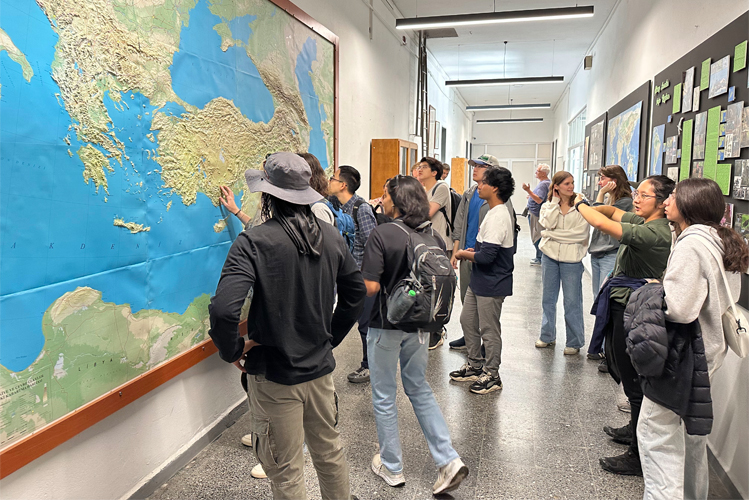“Geologically, Canada is about as boring as you can get,” says Erica Rose, a fourth-year earth sciences student with St. Michael’s College.
“But the geology of Türkiye is amazing. The region is relatively young in terms of the geologic time scale,” she says. “There are three tectonic plates moving around in the region so there are real tectonic effects that you can see and measure in real time.”
Rose was in Türkiye earlier this year with students and instructors taking part in an earth sciences International Course Module (ICM). ICMs are opportunities for students to enhance their course work with trips abroad, with the Faculty of Arts & Science and the Department of Earth Sciences covering travel and living expenses.
Rose and her fellow students traveled to Istanbul and central Anatolia (Türkiye) as part of their Geologic Structures and Maps (ESS241H) and Global Tectonics (ESS445H) courses. The trip was led by professors Tasca Santimano and Russell Pysklywec, both from the Department of Earth Sciences. Students learned about the tectonics of the region and explored how the lives of humans are intricately linked to geology.
A&S News spoke to Rose following the ICM.
How was the trip!?
It was great. Because I’m in both courses, I already knew everybody who went. So, it was fun to go with a group of people I'm friends with and who are interested in and passionate about the same things as me. Also, it was perfect for me because I know I want to study tectonics — structural, “big form” processes — just like the ones that are happening in Türkiye. There was no way I was going to pass up this trip. It was an experience like no other!

Can you explain more about why Türkiye is so interesting geologically?
The region is called the Anatolian sub-plate. That's what Türkiye is sitting on. And there are plates all around it: the Eurasian plate to the north and the big African and Arabian plates to the south that are pushing north.
So it's sort of like Türkiye is being squished by the other plates. That's why there's so much fun, crazy stuff happening there geologically. There are so many different features like mountains, plateaus, as well as basins forming on those plateaus. As soon as we got out of the airport, we saw a volcano. That was a big moment for me — I just about cried! There were the ‘fairy chimneys’ which are towers of rock that have eroded to look like the chimneys of dwellings where fairies would live. It’s a geologist's dream.
One of the goals of the ICM was to explore how people’s lives and the region’s geology are linked. Did you see that?
For sure. There’s this rock called ignimbrite which is made up of volcanic ash and debris that's been compressed and heated, and it’s used as a building material. And sometimes, they just carve right into it and carve out a house. We even stayed in cave hotels. Also, the volcanos leach elements and minerals into the soil which make the region amazing wine country.

Was it all work while you were there?
Not at all. Most of the time we spent in Istanbul was just taking in the culture. We did a lot of the big mosque tours and went to the Hagia Sofia Grand Mosque. We saw all the other sites that Istanbul is famous for like the Grand Bazaar. But I think the culture of Istanbul was what stood out for me: the cobblestone roads, the tightly packed buildings, how sociable everyone is. It was amazing to see a different way of life.
What would you say to a student thinking about going?
I would say without hesitation: Go! For one thing, travel can be a challenge for students. But with the ICM, meals and almost everything is paid for. So financially, going on an ICM makes so much sense. Plus, the opportunity to see with our own eyes what we're learning about in class is unparalleled. We joke in the earth sciences department that Toronto is not the most relevant place to study geology. There's really no geology here. But getting to see the geology for yourself, it really solidifies in my mind, everything that we've been working towards and what the future could hold for us students.

